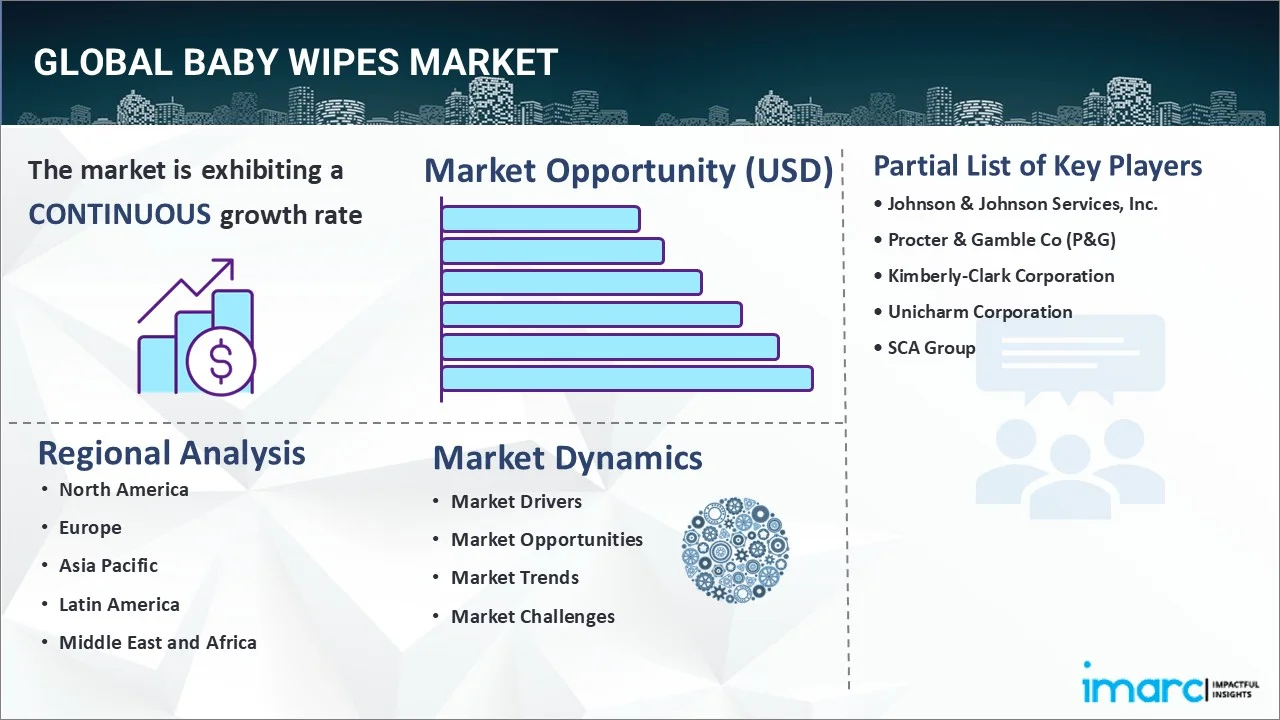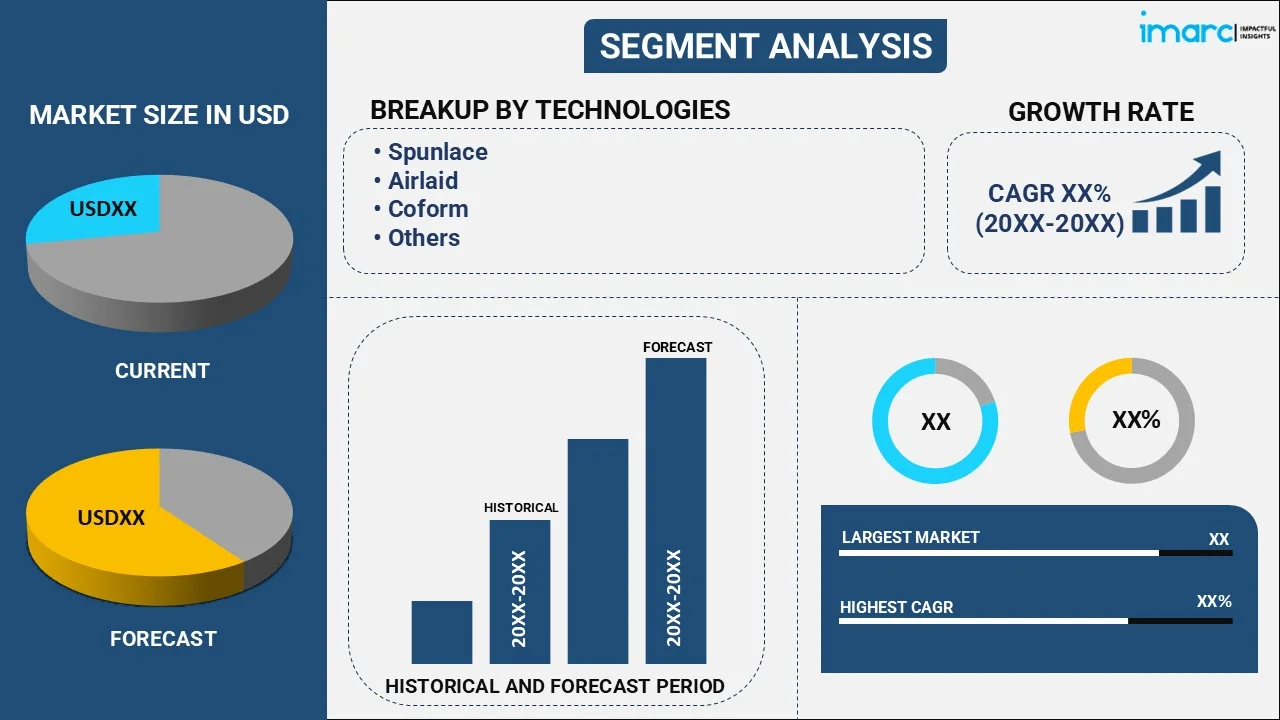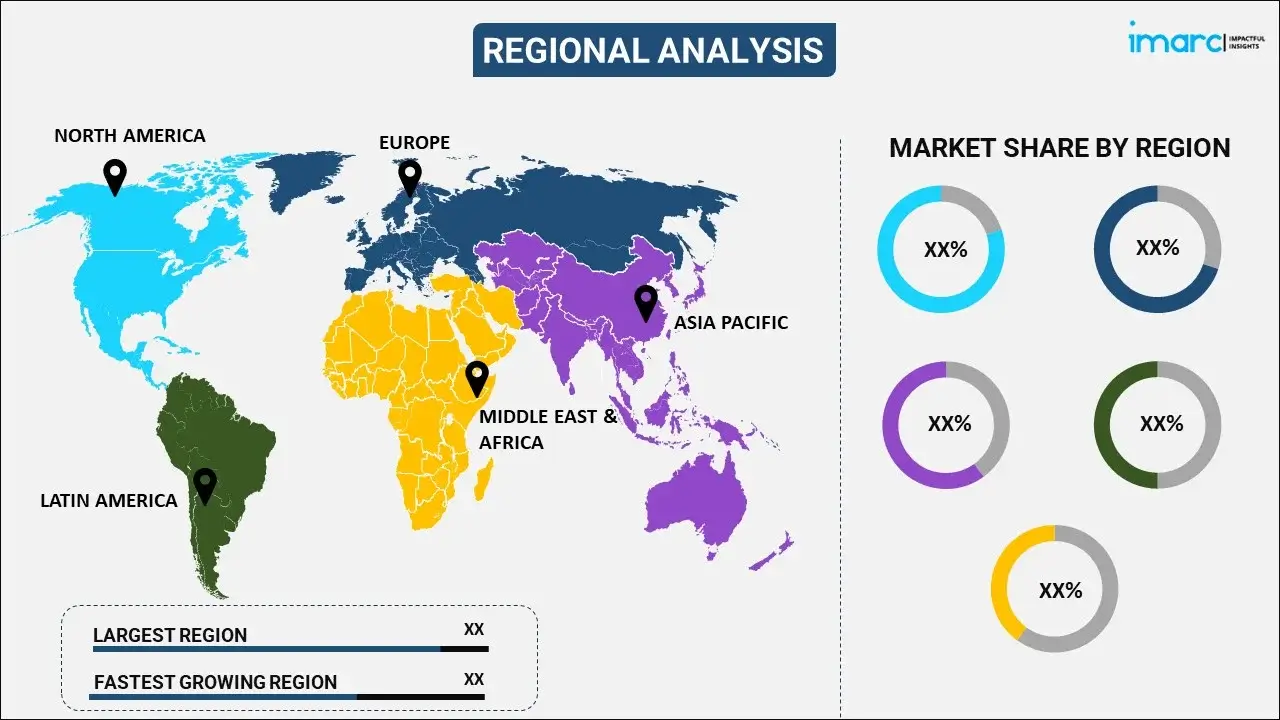
Baby Wipes Market Report by Technology (Spunlace, Airlaid, Coform, Needlepunch, Composite, and Others), Product Type (Dry Wipes, Wet Wipes), Distribution Channel (Supermarkets and Hypermarkets, Pharmacies, Convenience Stores, Online Stores, and Others), and Region 2025-2033
Baby Wipes Market Overview:
The global baby wipes market size reached USD 5.0 Billion in 2024. Looking forward, IMARC Group expects the market to reach USD 6.4 Billion by 2033, exhibiting a growth rate (CAGR) of 2.69% during 2025-2033. The growing population of infants and toddlers, increasing awareness of hygiene and health among parents, and rising number of working parents and busy lifestyles are some of the major factors propelling the market.
|
Report Attribute
|
Key Statistics
|
|---|---|
|
Base Year
|
2024
|
|
Forecast Years
|
2025-2033
|
|
Historical Years
|
2019-2024
|
|
Market Size in 2024
|
USD 5.0 Billion |
|
Market Forecast in 2033
|
USD 6.4 Billion |
| Market Growth Rate 2025-2033 | 2.69% |
Baby Wipes Market Analysis:
- Market Growth and Size: The global baby wipes market is experiencing steady growth, driven by increasing birth rates and heightened awareness about infant hygiene.
- Major Market Drivers: Key factors include innovations in biodegradable and organic wipes in response to the growing demand for environment-friendly and skin-safe products.
- Key Market Trends: The integration of advanced technologies in manufacturing to produce ultra-soft, durable, and absorbent wipes.
- Geographical Trends: North America dominates the market, driven by the increasing birth rates. However, Asia Pacific is emerging as a fast-growing market on account of the rising awareness about infant hygiene and the presence of various baby care brands.
- Competitive Landscape: Companies are focusing on product innovation, quality improvement, and mergers and acquisitions (M&A) to enhance their market share and address diverse user needs, ranging from eco-friendly products to premium, specialized wipes.
- Challenges and Opportunities: Challenges, include stringent regulatory standards, the environmental impact of disposable wipes, and intense competition. However, opportunities in developing eco-friendly and biodegradable wipes, tapping into emerging markets, and leveraging online retail platforms to enhance product accessibility and user engagement are projected to overcome these challenges.

Baby Wipes Market Trends/Drivers:
Growing Population of Infants and Toddlers
The growing population of infants and toddlers directly impacts the baby wipes market by creating a larger consumer base. As the number of babies increases, so does the demand for products that cater to their specific needs. Baby wipes provide a convenient and efficient solution for maintaining hygiene during diaper changes and general clean-ups. With a larger population of infants and toddlers, parents seek time-saving and practical solutions, making baby wipes an essential item in their caregiving routine. Moreover, manufacturers recognize this demand and continue to develop and promote baby wipes to meet the growing needs of this expanding consumer segment.
Increasing awareness about health and hygiene among parents
As parents become more conscious of maintaining cleanliness for their infants, they seek products that can effectively and safely address their hygiene concerns, thus propelling the market for personal care products like baby wipes. Baby wipes provide a convenient solution for quick and thorough clean-ups, particularly during diaper changes. Parents value the convenience, portability, and effectiveness of baby wipes in maintaining their baby's hygiene. With the growing importance of hygiene in preventing infections and promoting overall well-being, manufacturers are developing baby wipes with gentle formulations that prioritize the health and safety of infants.
Advancements in product innovation
The advancements in product innovation, such as the introduction of new features and improved formulations, cater to the evolving needs of parents and infants. Other than this, manufacturers are launching biodegradable wipes that constantly strive to enhance the quality, functionality, and eco-friendliness of baby wipes. Furthermore, innovations, such as textured wipes, for better cleaning, hypoallergenic formulations for sensitive skin, or wipes with added skincare benefits like moisturizing or soothing properties, create differentiation and attract consumers seeking specialized solutions.
Baby Wipes Industry Segmentation:
IMARC Group provides an analysis of the key trends in each segment of the global baby wipes market report, along with forecasts at the global and regional levels from 2025-2033. Our report has categorized the market based on technology, product type, and distribution channel.
Breakup by Technology:

- Spunlace
- Airlaid
- Coform
- Needlepunch
- Composite
- Others
The report has provided a detailed breakup and analysis of the baby wipes market based on technology. This includes spunlace, airlaid, coform, needlepunch, composite, and others.
Spunlace is a nonwoven fabric manufacturing process that involves entangling fibers together through high-pressure water jets. It creates a fabric with a soft, cloth-like texture, high strength, and excellent absorbency. Spunlace fabrics are commonly used in baby wipes due to their gentle and non-irritating properties.
Airlaid is another nonwoven fabric production method. It involves blending pulp fibers with air and a binder to form a loose web-like structure. Heat and pressure are then applied to bond the fibers together. Airlaid fabrics are known for their high absorbency, softness, and bulkiness. They are often used in baby wipes to provide superior absorbency and a cushiony feel.
Coform, also known as composite formation, combines two or more types of fibers, typically pulp and synthetic fibers, using a combination of air and water jets. This process creates a nonwoven fabric with enhanced strength, absorbency, and softness. Coform fabrics are commonly used in baby wipes to provide a balance between strength and absorbency while maintaining a soft and gentle touch on the baby's skin.
Breakup by Product Type:
- Dry Wipes
- Wet Wipes
A detailed breakup and analysis of the baby wipes market based on the product has also been provided in the report. This includes dry wipes and wet wipes.
Dry wipes refer to nonwoven or woven fabric sheets that are used without any added moisture or solution. They are versatile and can be used for various purposes, including as baby wipes. Dry wipes are typically soft and gentle, making them suitable for sensitive baby skin. They can be used for dry cleaning, such as wiping away excess moisture or residue during diaper changes or for general cleaning purposes. Dry wipes offer convenience and can be customized by adding water or a preferred cleaning solution, allowing parents to control the level of wetness or choose a specific cleansing agent.
Wet wipes, on the other hand, are pre-moistened with a solution, usually water-based and containing mild cleansers and additives. They are ready-to-use and provide a convenient and efficient way to clean the baby's skin. Wet wipes are specifically designed for gentle cleansing during diaper changes and for wiping sensitive areas, such as the face and hands. The moistened fabric helps to remove dirt, impurities, and residue effectively while maintaining the skin's moisture balance. Wet wipes often come in resealable packaging to prevent drying out and ensure freshness. They offer quick and hygienic cleaning, especially when access to water and soap is limited.
Breakup by Distribution Channel:
- Supermarkets and Hypermarkets
- Pharmacies
- Convenience Stores
- Online Stores
- Others
Supermarkets and hypermarkets dominate the baby wipes market
The report has provided a detailed breakup and analysis of the baby wipes market based on the distribution channel. This includes supermarkets and hypermarkets, pharmacies, convenience stores, online stores, and others. According to the market report, supermarkets and hypermarkets represented the largest segment.
Hypermarkets and supermarkets are large retail stores that provide a wide range of baby care products, including baby wipes, under one roof. Their extensive shelf space and variety of brands and options make it convenient for parents to find and purchase baby wipes during their routine shopping trips. These stores are one-stop shopping destinations where parents can find a wide range of products, including baby supplies. They also often offer competitive pricing, discounts, and promotional offers, attracting price-conscious consumers. Moreover, their strategic location and accessibility ensure that baby wipes are readily available to a large customer base. The presence of baby wipes in these retail outlets helps create awareness, drive sales, and meet the demand of parents seeking convenient and reliable solutions for their baby care needs.
Breakup by Region:

- North America
- Asia-Pacific
- Europe
- Latin America
- Middle East and Africa
North America exhibits a clear dominance, accounting for the largest baby wipes market share.
The report has also provided a comprehensive analysis of all the major regional markets, which include North America, Asia-Pacific, Europe, Latin America, and Middle East and Africa. According to the market report, North America was the largest market for baby wipes.
North America has a large population of infants and toddlers, creating a substantial consumer base for baby care products. Additionally, the parents across this region are increasingly focused on convenience and hygiene, leading to a high demand for baby wipes. Additionally, North America has a strong retail infrastructure, including supermarkets, hypermarkets, and online platforms, providing easy accessibility to baby wipes. This along with the strong emphasis on hygiene and cleanliness in North American culture, including when it comes to caring for babies and young children, the baby wipes market demand has been accelerated. Furthermore, North America is home to several major manufacturers and brands in the baby care industry, contributing to product innovation, advertising, and distribution.
Competitive Landscape:
The key players focus on continuous product innovation to enhance features and cater to specific needs. This includes developing eco-friendly and biodegradable wipes, introducing hypoallergenic and dermatologically tested options, and incorporating additional benefits like moisturizing or soothing properties. Additionally, they invest in marketing and advertising campaigns to create awareness and promote their products. This includes targeted advertisements, collaborations with influencers or parenting communities, and social media engagement. Besides this, key players expand their distribution networks by partnering with retail chains, supermarkets, and online platforms to ensure wide availability of their products. Other than this, they engage in strategic pricing, competitive offers, and discounts to attract consumers and drive the demand. By combining these efforts, key players actively contribute to the baby wipes market growth.
The report has provided a comprehensive analysis of the competitive landscape in the global baby wipes market. Detailed profiles of all major companies have also been provided. Some of the key players in the market include:
- Johnson & Johnson Services, Inc.
- Procter & Gamble Co (P&G)
- Kimberly-Clark Corporation
- Unicharm Corporation
- SCA Group
Recent Developments:
- In August 2021, Unicharm Corporation introduced Mamy Poko Premium Baby Wipes in Taiwan and Greater China. These wipes utilize an organic cotton compound sheet certified STANDARD100 by OEKO-TEX®, ensuring the world’s highest safety standard, while also holding FSC Certification for environmental responsibility.
- In March 2024, Kimberly-Clark Corporation and Baby2Baby joined forces to provide millions of diapers and wipes, while tripling their Maternal Health & Newborn Supply Kit Initiative, demonstrating a commitment to supporting maternal and newborn health through essential baby care products.
Baby Wipes Market Report Scope:
| Report Features | Details |
|---|---|
| Base Year of the Analysis | 2024 |
| Historical Period | 2019-2024 |
| Forecast Period | 2025-2033 |
| Units | Billion USD |
| Scope of the Report | Exploration of Historical and Forecast Trends, Industry Catalysts and Challenges, Segment-Wise Historical and Predictive Market Assessment:
|
| Technologies Covered | Spunlace, Airlaid, Coform, Needlepunch, Composite, Others |
| Product types Covered | Dry wipes, wet wipes |
| Distribution channels covered | Supermarkets and hypermarkets, Pharmacies, Convenience stores, Online stores, Others |
| Regions Covered | Asia Pacific, Europe, North America, Latin America, Middle East and Africa |
| Companies Covered | Johnson & Johnson Services, Inc., Procter & Gamble Co (P&G), Kimberly-Clark Corporation, Unicharm Corporation and SCA Group |
| Customization Scope | 10% Free Customization |
| Post-Sale Analyst Support | 10-12 Weeks |
| Delivery Format | PDF and Excel through Email (We can also provide the editable version of the report in PPT/Word format on special request) |
Key Benefits for Stakeholders:
- IMARC’s report offers a comprehensive quantitative analysis of various market segments, historical and current market trends, market forecasts, and dynamics of the baby wipes market from 2019-2033.
- The research study provides the latest information on the market drivers, challenges, and opportunities in the global baby wipes market.
- The study maps the leading, as well as the fastest-growing, regional markets.
- Porter's five forces analysis assist stakeholders in assessing the impact of new entrants, competitive rivalry, supplier power, buyer power, and the threat of substitution. It helps stakeholders to analyze the level of competition within the baby wipes industry and its attractiveness.
- Competitive landscape allows stakeholders to understand their competitive environment and provides an insight into the current positions of key players in the market.
Key Questions Answered in This Report
The global baby wipes market was valued at USD 5.0 Billion in 2024.
We expect the global baby wipes market to exhibit a CAGR of 2.69% during 2025-2033.
The rising environmental consciousness, along with the introduction of eco-friendly, plant-based, organic, and natural variants that are made without harmful and toxic skincare ingredients, is primarily driving the global baby wipes market.
The sudden outbreak of the COVID-19 pandemic has led to the shifting consumer preferences from conventional brick-and-mortar distribution channels towards online retail platforms for the purchase of baby wipes.
Based on the distribution channel, the global baby wipes market can be segmented into supermarkets and hypermarkets, pharmacies, convenience stores, online stores, and others. Currently, supermarkets and hypermarkets hold the majority of the total market share.
On a regional level, the market has been classified into North America, Asia-Pacific, Europe, Latin America, and Middle East and Africa, where North America currently dominates the global market.
Some of the major players in the global baby wipes market include Johnson & Johnson Services, Inc., Procter & Gamble Co (P&G), Kimberly-Clark Corporation, Unicharm Corporation, and SCA Group.
Need more help?
- Speak to our experienced analysts for insights on the current market scenarios.
- Include additional segments and countries to customize the report as per your requirement.
- Gain an unparalleled competitive advantage in your domain by understanding how to utilize the report and positively impacting your operations and revenue.
- For further assistance, please connect with our analysts.
 Inquire Before Buying
Inquire Before Buying
 Speak to an Analyst
Speak to an Analyst
 Request Brochure
Request Brochure
 Request Customization
Request Customization




.webp)




.webp)












